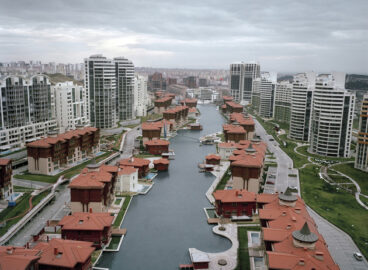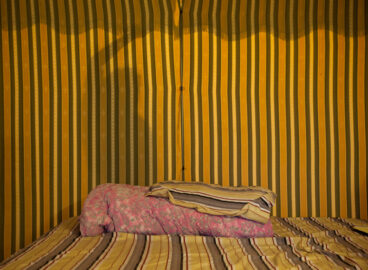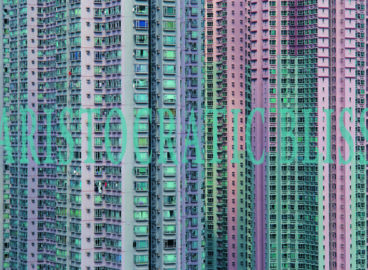Uneven Growth: Tactical Urbanisms for Expanding Megacities holds within its conceptual grasp two vastly different scales: the incomprehensible colossus of the megacity and the small tactics of everyday life by which urban dwellers claim authorship of their homes.
Exploring both scales, this bibliography offers divergent ideas related to the city—among them, spatial justice, the right to the city, participatory design, and the production of space—seen through the interpretive lenses of artists, architects, geographers, anthropologists, political theorists, sociologists, and a Jesuit priest. Nowhere near comprehensive, this collection of writings sets in conversation some of the multiple voices that comment on the contemporary city and its inequalities. Saskia Sassen tracks the broad network of specialized service firms that engage in a “practice of global control,” and AbdouMaliq Simone turns to the provisional local economies of Pikine, a suburb of Dakar, to discover the “city yet to come”; while in Los Angeles, Edward Soja uncovers the “consequential” geographies that function as dynamic forces in the ways that justice and injustice unfold within the city. Behind each book is a constellation of counterarguments, like-minded thinkers, and entire disciplinary languages for describing cities.
The diverse writings listed in this bibliography cohere around the notion of the city not as a fixed form, but rather as a site in constant transformation impelled by spatial, socioeconomic, and political processes. The contemporary city is the site of some of the most asymmetrical and deeply contradictory aspects of capitalism, yet many of the authors presented here share a conviction that a greater investment in its diversity and disorder can help mobilize new alternatives or spark surprising revisions.
Source contents
Beyond Shelter: Architecture and Human Dignity
By Marie Aquilino, ed., 2011
Publisher: Metropolis Books, New York
Language: English
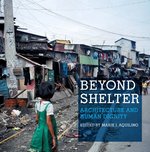
Beyond Shelter presents twenty-five small-scale case studies across Latin America, Asia, Africa, and the U.S. in which professional teams worked with communities in the aftermath of disasters to devise pragmatic design solutions. The book pointedly asks architects to take greater responsibility in designing for short-term emergencies and to rethink longer-term disaster-resilient strategies. Featured projects are by architects (among them Arup, Estudio Teddy Cruz, and Urban Think Tank) as well as larger humanitarian organizations such as the Red Cross and UN-Habitat. Each project is explained and detailed step-by-step.
“Deep Democracy: Urban Governmentality and the Horizon of Politics”
By Arjun Appadurai, 2002
Publisher: Public Culture 14: 21–47
Language: English, French
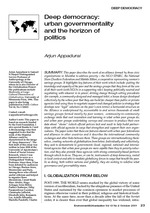
Anthropologist Appadurai tells the story of the Alliance, a group of nongovernmental organizations in Mumbai. Working with the urban poor, the Alliance organizes housing exhibitions to discuss designs for dwellings that meet the needs of the families who will occupy them; establishes a community-to-community exchange in which the poor conduct their own census; and inaugurates toilet festivals, bawdy celebrations of functioning public toilets. Appadurai explores what he terms “deep democracy,” the confrontation of inequality from below through emergent strategies of self-governance in which disenfranchised groups make conspicuous claims to citizenship.
Actions: What You Can Do with the City (Comment s’approprier la ville)
By Giovanna Borasi, and Mirko Zardini, eds., 2008
Publisher: Canadian Centre for Architecture, Montreal; SUN, Amsterdam
Language: English, French

This catalogue is part of a three-part project by the Canadian Centre for Architecture that also included an exhibition and a website. Identifying the contemporary metropolis as structured by patterns of consumption that are inherently fragile, subject to control, and socially and economically divisive, the catalogue documents a countercurrent of small-scale and plural practices that spontaneously make use of the city: from borrowed buildings for temporary offices to urban agriculture and the appropriation of urban terrain for soccer games. A collection of short “Thoughts” by a range of authors is interwoven with thirty-four “Actions” culled from the exhibition.
Cities for People, Not for Profit: Critical Urban Theory and the Right to the City
By Neil Brenner, Peter Marcuse, and Margit Mayer, eds., 2011
Publisher: Routledge, London and New York
Language: English

A response to the recent economic crisis and the still-unfolding repercussions for cities everywhere, Cities for People offers an introduction to critical urban theory and issues an urgent call to shape cities “to human social needs” rather than for profit. Essays by planners, urban theorists, sociologists, and political scientists provide a broad range of interpretations of contemporary urban transformations. To borrow from David Harvey’s conclusion “What is to be done? And who the hell is going to do it?,” this volume seeks to identify the practices and actors needed to rally urban alternatives. Cities for People provides a wide-angle view of the global circumstances—neoliberal restructuring, the foreclosure crisis, “creative” cities—against which architects and urbanists are rethinking built and urban environments.
L’Invention du Quotidien (The Practice of Everyday Life)
By Michel de Certeau, 1980, 1984
Publisher: Union Générale d’Editions, Paris, 1980; translated by Steven Rendall, Berkeley: University of California Press, 1984
Language: French, English
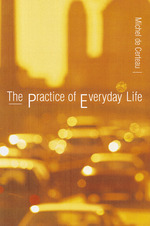
Everyday practice, de Certeau asserts, is a “multifarious and silent ‘reserve’ of procedures”—a repository of tactics through which the individual is able to reclaim autonomy in the city. He contrasts this with strategies, that is “force-relationships” imposed by institutional structures of power. His investigation of seemingly ordinary everyday activities reveals them to be canny procedures and surprising ruses. These activities span the practice of reading, rituals and routines, the art of cooking, and perhaps most saliently, activities such as walking, which reorder urban space.
Every Day is for the Thief
By Teju Cole, 2014
Publisher: Random House, New York
Language: English
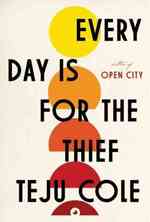
In this spare, episodic novel, a young Nigerian doctor returns to Lagos after many years away to rediscover the city. In a series of short chapters, he describes scenes from Internet cafes, traverses the city by its chaotic bus system, witnesses small-scale acts of corruption, and recalls an outbreak of violence at an outdoor market. These vignettes compose a complex yet humane portrait of a teeming city in which even “The air in the strange, familiar environment of this city is dense with story, and it draws me into thinking of life as stories. The narratives fly at me from all directions.” Black-and-white photographs of the city, taken by Cole, accompany the narrative.
“Des Espaces Autres” (Of Other Spaces: Utopias and Heterotopias)
By Michel Foucault, 1984, 1986
Publisher: Architecture, Mouvement, Continuité, no. 5 (October 1984): 46–49; translated by Jay Miskowiec in Diacritics 16, no. 1 (Spring, 1986): 22–27.
Language: French, English
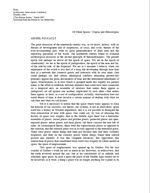
In this essay, Foucault rescues space from the void, describing it as an active and heterogeneous medium. He introduces the curious idea of the heterotopia—a counter-space that exists outside the usual order of things as a “simultaneously mythic and real contestation of the space in which we live.” Offering examples that range from prisons to temporary fairgrounds, holiday villages to ships at sea, he suggests that the heterotopia serves to compensate for or expose the shortcomings of “real space.” Enigmatic in its implications—interpreted both as a rebellious suggestion and, alternately, as a disciplinary strategy—Foucault’s essay provides richly evocative ideas for the imaginative tactics of contemporary urban interventions.
Loose Space: Possibility and Diversity in Urban Life
By Karen A. Franck and Quentin Stevens, eds., 2007
Publisher: Routledge, London and New York
Language: English
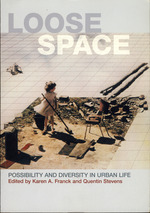
Moving across disparate geographies ranging from the inner-city streets of Bangkok to social housing complexes in Athens, this collection of essays theorizes what editors Franck and Stevens term “loose space”—the dynamic appropriation of urban landscapes for unexpected uses. The authors are interested in how these spaces “loosen up the dominant meanings of specific sites” to allow “new perceptions, attitudes, and behaviors.” Four themes structure this exploration of loose space: appropriation, tension, resistance, and discovery. Contrasting these emancipatory moments to the tight controls of the city of late capitalism, looseness is suggested as a critical practice for future engagement.
Splintering Urbanism: Networked Infrastructures, Technological Mobilities, and the Urban Condition
By Stephen Graham and Simon Marvin, 2001
Publisher: Routledge, London and New York
Language: English
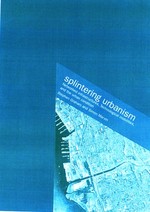
Analyzing the relationship between systems of infrastructure and urban space, this interdisciplinary book provides a critical look at the ways in which electricity, water, roads, telecommunications, and their regulation shape cities. The first half of the book traces the historical framework of public infrastructure, looking at the physical developments and related standardization of services that were formative to the modern city. The latter half follows the contemporary shift from publicly owned networks to an increasingly complex infrastructural landscape fragmented by privatization and public-private partnerships. Case studies in Singapore, Jakarta, Mumbai, and elsewhere support the analysis.
“The Right to the City”
By David Harvey, 2008
Publisher: New Left Review 53: 23–40
Language: English
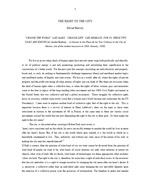
In this brief essay, Harvey revives and expands Henri Lefebvre’s clarion call for the right to the city (see below). He describes urbanization as a process always structured by uneven accumulations of capital, in which large-scale infrastructure projects are used to stabilize and suppress class conflict, from Haussmann’s rebuilding of Paris under Napoleon III to the mass suburbanization of the U.S. following World War II. This process is always accompanied by the dispossession of large numbers of urban poor. Harvey argues that the contemporary free market has only widened this class disparity. He asserts that the right to the city—the “freedom to make and remake ourselves and our cities”—is a basic but neglected human right. This essay is just the tip of an expansive body of work. See also: Harvey, Social Justice and the City (University of Georgia Press: 2009 [1973]) and Justice, Nature and the Geography of Difference (Cambridge, Mass.: Blackwell, 1996).
Insurgent Public Space: Guerrilla Urbanism and the Remaking of Contemporary Cities
By Jeffrey Hou, ed., 2010
Publisher: Routledge, New York
Language: English
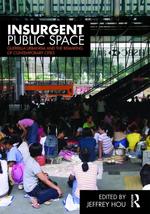
This collection of twenty-one essays by anthropologists, scholars, architects, geographers, and artists highlights narratives about the ways in which marginalized city dwellers have reclaimed public spaces. Citing the decrease in conventional public space afforded by plazas and city parks through regulation and conversion into privately operated malls and festival marketplaces, these essays provide compelling examples of “smaller yet grander” public spaces remade through acts of insurgency. Temporary events, guerrilla acts, and ad hoc appropriations by individuals and small grassroots groups acting without state subsidies or infrastructure are shown capable of fostering a more open and inclusive public space. Insurgent Public Spaces emphasizes stories of the Asia-Pacific region.
“The Uses of Sidewalks: Safety,” in The Death and Life of Great American Cities
By Jane Jacobs, 1961, 1992
Publisher: Vintage Books, New York, pp. 29–54
Language: English
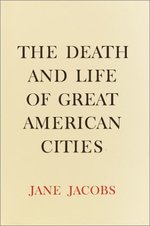
Jacobs’s writings, along with the work of the advocacy planners of the late 1960s and 1970s, mounted a powerful critique of the planning establishment as epitomized by Robert Moses and the postwar urban renewal projects that rebuilt large portions of American cities. Aspects of Jacobs’s work inspire many of the small-scale, community-oriented interventions currently reordering U.S. cities. In this chapter Jacobs claims that the street is much more than the functional architecture of the city; it is a diverse public space and a site through which pedestrians become active participants in the formation and safety of city life. She describes the everyday interactions along its length as “the scene of an intricate sidewalk ballet.”
“The Right to the City”
By Henri Lefebvre, 1993
Publisher: In Lefebvre, Writings on Cities, translated by Eleonore Kofman and Elizabeth Lebas, Blackwell, Oxford, 1996, pp. 147–159.
Language: English
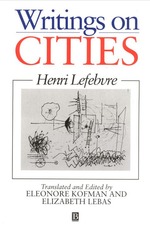
Written just prior to the demonstrations of 1968, Lefebvre’s manifesto-essay is “a cry and a demand” for the right to the city. In a series of sketches, the essay condemns what the author sees as the alienating conditions of modern urban life, embodied by rational planning and new towns, and calls for a city that is a collective work emerging from interaction and creative acts by the diverse “groups, social classes and class fractions” that compose the city. This essay, paired with Lefebvre’s later The Production of Space, which endeavors to reconcile social, physical, and mental space, has been highly influential among architects, geographers, and political theorists writing on the negotiations of architecture, space, and social practice.
Maximum City: Bombay Lost and Found
By Suketu Mehta, 2004
Publisher: Vintage Books, New York
Language: English

This vivid portrait of Bombay is part ethnographic study and part memoir. Mehta, a journalist and fiction writer, describes a city animated by endless transactions and exchanges, where privacy is in short supply and people make their livelihoods in innumerable, often surprising ways. Bombay’s many subcultures are explored in detailed profiles of, among others, a policeman famous for his interrogations of gang members, a dancer at a ladies’ bar, and a Hindu fundamentalist who took part in the anti-Muslim riots of 1992–93. A discussion of government planning projects, the Bombay Rent Act and its fraught relationship to private property, as well as the city’s attempts to reinvent itself through redrawing maps and renaming streets establishes the complex landscape of these personal narratives.
Favela: Four Decades of Living on the Edge in Rio de Janeiro and The Myth of Marginality: Urban Poverty and Politics in Rio de Janeiro
By Janice Perlman, 2010, 1976
Publisher: Oxford University Press, New York; University of California Press, Berkeley
Language: English

In The Myth of Marginality Perlman dismantles a long-standing myth of squatter settlements or shantytowns as marginal spaces. Fieldwork from three areas of Rio de Janeiro—the favela of Catacumba in Rio’s South Zone, the favela of Nova Brasília in the North Zone, and Duque de Caxias, a municipality in the Baixada Fluminense region—portray communities that form an essential part of the urban economy and are “tightly integrated [into society], albeit in an asymmetrical manner.” In Favela, Perlman revisits these same neighborhoods thirty years later to interview residents and community leaders who participated in her original study as well as their children and grandchildren. Combining anecdotes and interviews with quantitative and survey data, the book reflects on the trajectory of the residents’ lives against a larger backdrop of social, economic, and architectural change.
“Urban Informality: Toward an Epistemology of Planning”
By Ananya Roy, 2005
Publisher: Journal of the American Planning Association 71, no. 2: 147–158
Language: English
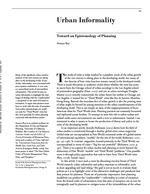
This clearly written essay provides a critical look at two themes that have dominated the discussion of informality in cities of the global south—the supposed crisis of “informal hypergrowth” and the vision of informality as a model of “heroic entrepreneurship.” Roy proposes an alternative view of informality, presenting it as “a series of transactions that connect different economies and spaces together.” In her view, recognizing informality not as an external “object of development” but instead as a product of the state can reveal the limitations of conventional planning practices and provide models for its revision. Also on this topic, see Roy and Nezar Alsayyad, eds., Urban Informality: Transnational Perspectives from the Middle East, Latin America, and South Asia (Lanham, Md.: Lexington Books, 2004).
The Global City: New York, London, Tokyo
By Saskia Sassen, 1991 (reprinted 2001)
Publisher: Princeton University Press
Language: English
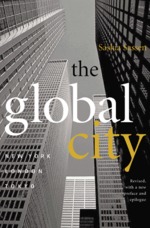
The Global City re-envisions the city as part of a transnational network of information, capital, and people. The economic might of global cities such as New York, London, and Tokyo, Sassen argues, is the result of a counterintuitive process of dispersal and centralization. On the one hand, new communication technologies allow for the dispersal of economic transactions that were once place-based; and on the other, the specialized financial agencies that coordinate and manage these transactions have become concentrated in a few global cities. This “practice of global control,” even as it creates new connections between cities far apart, has an alienating effect at the local scale: global cities tend to have limited investment in their immediate region, heightening the inequitable distribution of resources and contributing to an expanding informal economy.
For the City Yet to Come: Changing African Life in Four Cities
By AbdouMaliq Simone, 2004
Publisher: Duke University Press, Durham, N.C.
Language: English
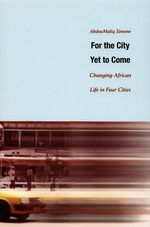
Countering a large body of work by government officials and urban planners that measures the success of African cities by how well they align with traditional narratives of development, Simone argues that these cities are sites of functioning or provisional economies as well as deep social networks. The study of this existing knowledge might “act as a platform for the creation of a very different kind of sustainable urban configuration than we have yet to generally know.” He presents four urban cases: the “informal” highlights social collaborations in Pikine, a large suburb of Dakar, Senegal; the “invisible” describes acts of collective resistance to government-sponsored developments in Winterveld, near Pretoria, South Africa; the “spectral” looks at how the city is imagined through the erection of a public sculpture assembled from found material in Douala, Cameroon; and “movement” focuses on the migration of people in and out of Jeddah, Saudi Arabia.
Seeking Spatial Justice
By Edward W. Soja, 2010
Publisher: University of Minnesota Press, Minneapolis
Language: English

Soja intertwines justice, space, and the city to argue compellingly that inequality has a spatial dimension. Drawing on ideas of critical geography—on the notion that specific places within a city confer certain advantages and disadvantages—Soja examines spatial justice through case studies in Los Angeles. Opening with the story of the Bus Riders Union, whose legal victory against the MTA resulted in the rerouting of the city’s transit system, the book makes the case for redressing hidden geographic inequities—from the redlining of urban districts to the uneven distribution of resources enabled by core-periphery city models.
Living as Form: Socially Engaged Art from 1991–2011
By Nato Thompson, ed., 2012
Publisher: Creative Time, New York
Language: English

This ambitious catalogue of essays and one hundred artists’ projects presents a broad cross section of socially engaged practices that conflate art, public space, and everyday life. With a nod to the celebrated 1969 exhibition Live in Your Head: When Attitudes Become Form, the book suggests that a spectrum of activities including debates, performances, and spatial occupations can constitute a “bottom-up” cultural resource. Living as Form provides a complementary set of practices for architects and urbanists rethinking built and urban environments, underscoring the interdisciplinary nature of the tools available for reinvesting in the city.
“Spontaneous Interventions: Design Actions for the Common Good”
By Cathy Lang Ho, Ned Cramer, David van der Leer, eds., August 2012
Publisher: Architect magazine
Language: English

Organized by Cathy Lang Ho, Ned Cramer, and David van der Leer for New York’s nonprofit Institute for Urban Design, which was chosen to represent the U.S. at the 2012 Venice Architecture Biennale, the exhibition Spontaneous Interventions featured 124 projects that fall within the burgeoning category of interventionist urbanism. Presented in this issue of Architect, which served as the exhibition catalogue, the projects are largely oriented toward the “local,” in that many look no further than improving the neighborhood. From chicken coops fashioned from supermarket carts to GOOD Ideas for Cities’ pairing of civic leaders with creative teams, the works highlight citizen activism as a means to reorder the planning and policies of American cities. Essays by the curators and a range of critics and interventionists reflect on the history of such activism and consider how it transforms urban experience. A website indexes the projects: http://www.spontaneousinterventions.org/interventions.
